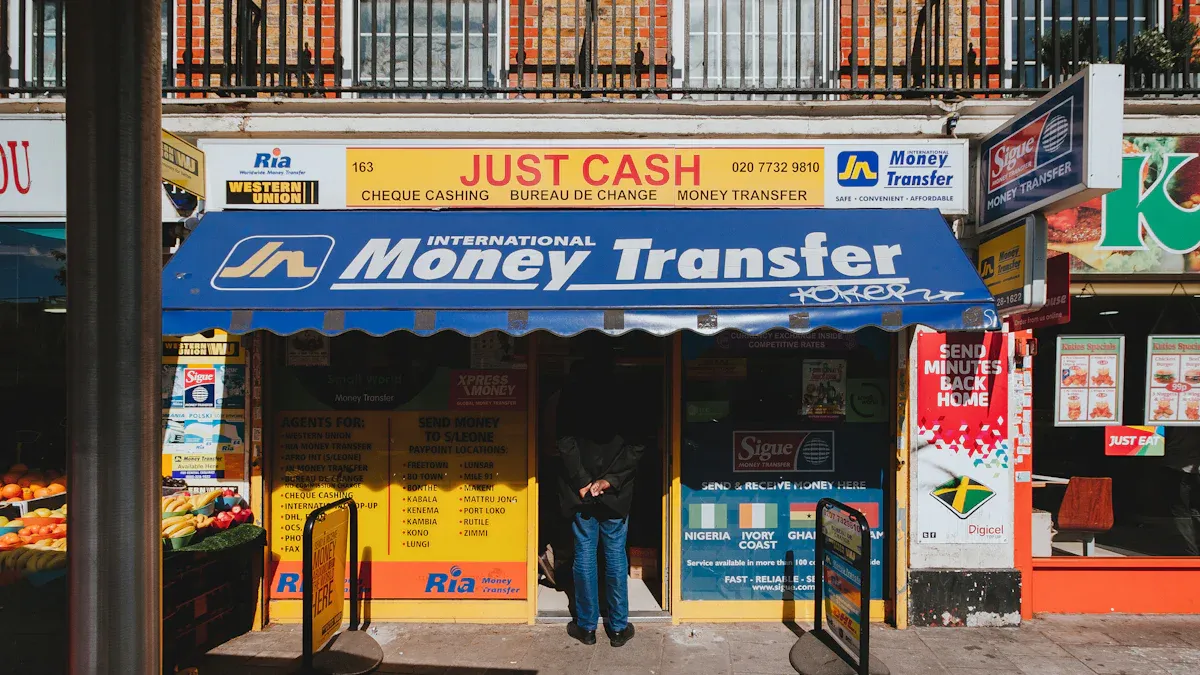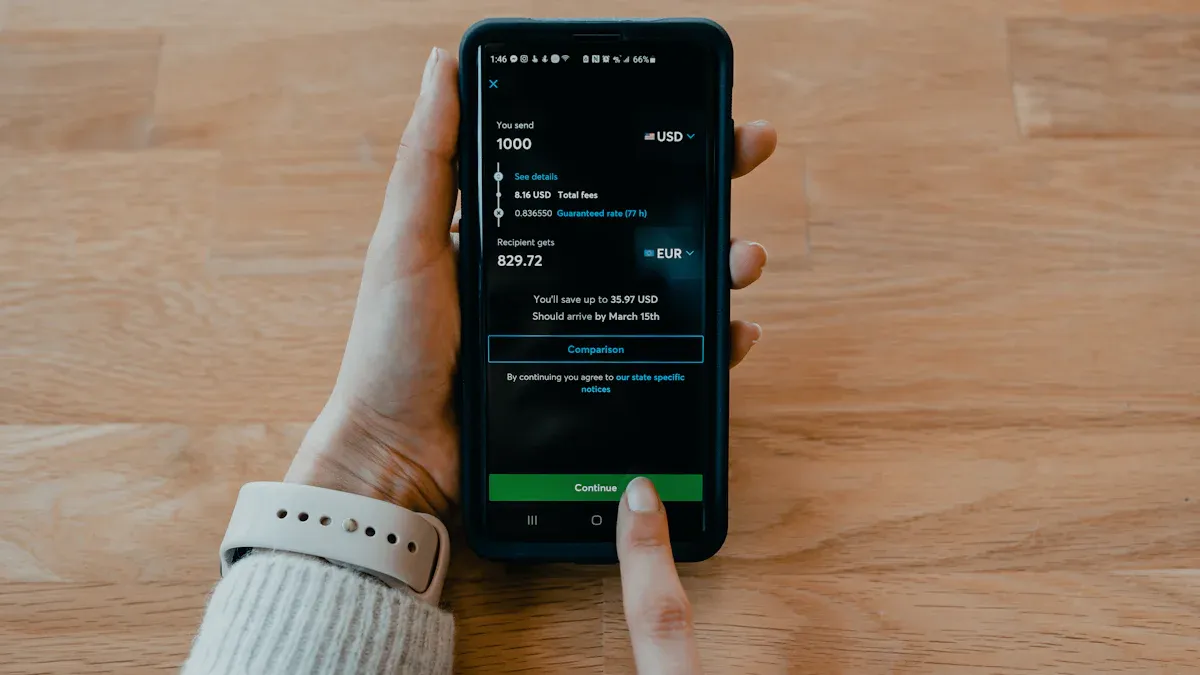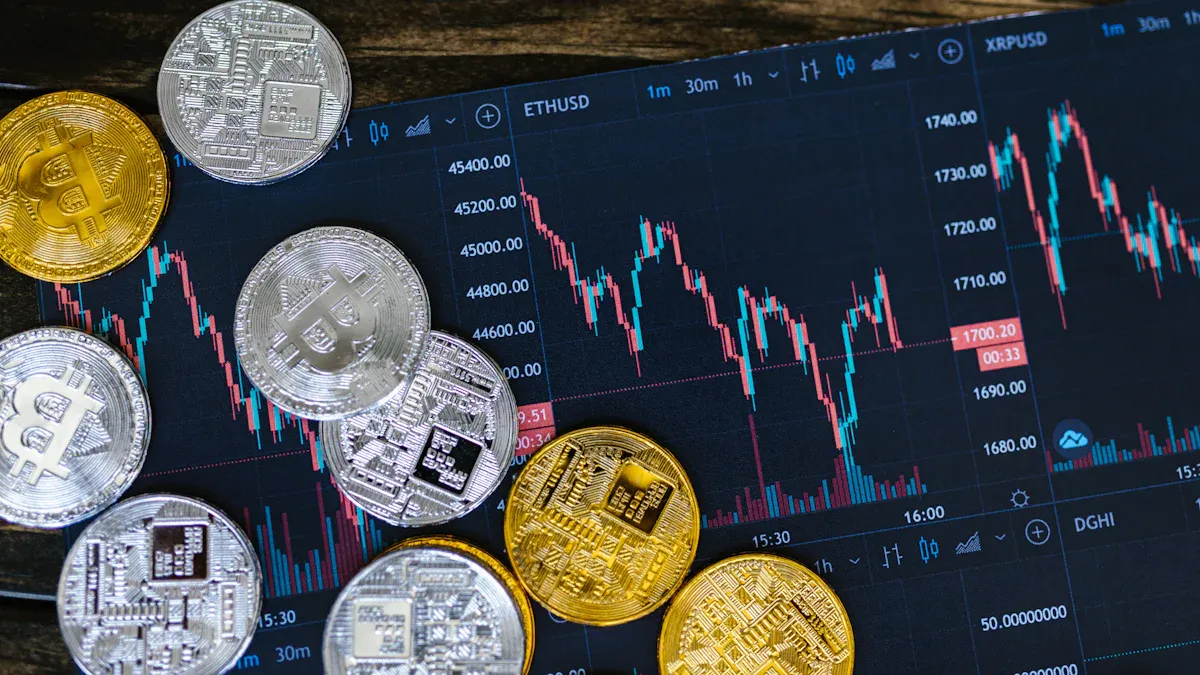- EasyCard
- Trade
- Help
- Announcement
- Academy
- SWIFT Code
- Iban Number
- Referral
- Customer Service
- Blog
- Creator
Stablecoin Remittance Fee Comparison: 3 Platforms to Help You Save Money

Image Source: unsplash
Want to remit money but worried about high bank handling fees? Stablecoins offer a more cost-saving solution. After conducting a stablecoin remittance fee comparison, you will find that the costs of traditional banks can be quite high.
Cost Comparison for Remitting $500
Method Estimated Fee Bank Transfer Approx. 15.13 USD Stablecoin Remittance A few cents to a few dollars
Combining operational convenience and fee transparency, BiyaPay is often the more cost-saving choice in direct fiat deposit and withdrawal scenarios. This article will provide real-world test comparisons of BiyaPay, Binance C2C, and OKX C2C across these three platforms.
Key Takeaways
- Stablecoin remittance is much cheaper than traditional banks, saving you money.
- USDT remittance involves four types of fees: buying spread, network fee, selling loss, and platform service fee.
- BiyaPay remittance fees are fixed and transparent, with simple operations, suitable for users seeking convenience.
- Binance and OKX C2C remittance fees are influenced by market prices and involve more operational steps.
- When choosing a remittance platform, consider the remittance amount, recipient region, and your need for operational convenience.
USDT Remittance Fee Structure
Before you start using USDT for remittance, understanding its complete cost structure is crucial. A successful stablecoin remittance fee comparison requires calculating every step from buying to selling. The total cost mainly consists of the following four parts.
Deposit Cost: Spread When Purchasing USDT
Your first cost comes from purchasing USDT. When you use fiat currency (such as RMB) to buy USDT, the price you pay is usually slightly higher than the real-time USD exchange rate. This difference is the “spread” or “premium”.
For example, the real-time exchange rate is 1 USD = 7.30 RMB. You might need 7.35 RMB to buy 1 USDT. The extra 0.05 RMB is your deposit cost.
This spread fluctuates based on the platform, trading method (C2C or direct platform exchange), and market supply and demand.
On-Chain Cost: Withdrawal Network Fee
After purchasing USDT, you need to transfer it from one platform to another or to a personal wallet. This process occurs on the blockchain and requires paying a network fee (Gas Fee) to miners or validators to process your transaction.
This fee depends on the blockchain network you choose. Different networks have vastly different fees and speeds.
| Network | Average Fee (USD) | Transaction Speed | Best Use Case |
|---|---|---|---|
| TRC20 (Tron) | $0.80 – $2.00 | 1-3 minutes | Cost-sensitive, high-frequency small transfers |
| ERC20 (Ethereum) | $5.00 – $50.00 | 3-15 minutes | High-value transactions prioritizing decentralization and security |
| BEP20 (BSC) | $0.50 – $1.00 | About 1 minute | Daily transactions seeking low cost and high efficiency |
Money-Saving Tip For most remittance scenarios, the TRC20 network offers the best value. Its fees are much lower than ERC20, saving you a significant amount.
Note that internal account transfers within exchanges are usually free. You only pay this network fee when withdrawing USDT to an external wallet address.
Withdrawal Cost: Loss When Selling USDT
When you send USDT to the destination and prepare to exchange it for local fiat currency (such as HKD), a withdrawal cost arises. Similar to deposits, the price at which you sell USDT is usually slightly lower than the real-time exchange rate. This difference is the “loss” on withdrawal.
For example, if the recipient sells 1000 USDT for HKD, the transaction price might be 1% lower than the bank’s real-time exchange rate, constituting the withdrawal cost.
Platform Fees: Additional Service Charges
Finally, some platforms may charge extra fees for specific services. These may include:
- Fiat Withdrawal Fee: Some platforms allow you to directly exchange USDT for fiat and withdraw to a bank account, which may incur a fixed percentage (e.g., 1%) or fixed amount fee.
- Trading Service Fee: A few platforms may charge a small service fee for each C2C transaction.
Adding these four costs gives you the true total cost of a USDT remittance.
Stablecoin Remittance Fee Comparison: Real-World Tests on Three Major Platforms

Image Source: unsplash
Theoretical knowledge is important, but real operations reveal the truth. Now, we use a unified case to complete a full stablecoin remittance fee comparison.
Unified Case
You need to remit the equivalent of 1,000 USD in RMB from mainland China, and the recipient wants to receive HKD in a Hong Kong bank account.
Reference Exchange Rate (for calculation example only):
- 1 USD = 7.30 RMB (CNY)
- 1 USD = 7.80 HKD
We will use this case to calculate the total costs step-by-step through BiyaPay, Binance C2C, and OKX C2C.
BiyaPay: 1:1 Exchange with Fixed Rates
BiyaPay offers a very direct remittance path, with its biggest feature being the simplification of deposit and withdrawal processes, especially in fiat exchange.
Operation Path and Cost Calculation:
- Deposit: You can deposit USDT into BiyaPay through various methods.
- Exchange: Directly exchange 1,000 USDT within the platform at a 1:1 ratio for 1,000 USD. This step has no spread loss, which is the core difference from C2C platforms.
- Withdrawal: Withdraw 1,000 USD to your Hong Kong bank account. BiyaPay charges a withdrawal fee, typically 1% (starting as low as 0.5%).
Cost Breakdown (BiyaPay):
- Deposit Spread: 0 USD (assuming you already have USDT or obtain it at par through other channels)
- On-Chain Fee: 0 USD (in-platform exchange, no on-chain transfer)
- Withdrawal Loss: 0 USD (platform settles at real-time rate, non-C2C transaction)
- Platform Fee: 1,000 USD * 1% = 10 USD
Total Cost: Approx. 10 USD
BiyaPay supports direct withdrawal to Hong Kong bank accounts, and you can also link accounts like OCBC for more convenient deposits and withdrawals.
Additional Value: One-Stop Investment Platform
BiyaPay is more than just a remittance tool. The exchanged USD can be used directly for investing in US stocks, Hong Kong stocks, and other global assets without withdrawal. This saves you the secondary transfer steps and fees from a remittance tool to a broker.
- Complete identity verification on BiyaPay.
- Deposit USDT and exchange for USD.
- Directly purchase US stocks in the trading market.
This feature provides great convenience for users who want to use funds for investment.
Binance C2C: Traditional C2C Model Costs
Binance is the world’s largest cryptocurrency exchange with a very active C2C (Customer-to-Customer) market. Using it for remittance requires three main steps: buying, transferring, and selling.
Operation Path and Cost Calculation:
- Deposit Cost (Buying USDT): You need to buy USDT from merchants on the Binance C2C market using RMB. The buying price is usually higher than the real-time rate.
- Assume C2C buying price is 1 USDT = 7.38 CNY.
- Buying 1,000 USDT costs: 1,000 * 7.38 = 7,380 CNY.
- At real-time rate of 7.30, this equals 7,380 / 7.30 ≈ 1,010.96 USD.
- Your deposit cost is approx. 10.96 USD.
- On-Chain Cost (Withdrawal): You need to withdraw USDT from the mainland China Binance account to the Hong Kong Binance account or directly to the recipient’s wallet. Using TRC20 network, the fee is usually fixed.
- TRC20 network withdrawal fee: Approx. 1 USDT (1 USD).
- Withdrawal Cost (Selling USDT): The recipient sells USDT for HKD on the Hong Kong C2C market. The selling price is usually lower than the real-time rate.
- Assume C2C selling price is 1 USDT = 7.72 HKD.
- The 999 USDT transferred (1000 - 1) can be sold for: 999 * 7.72 = 7,712.28 HKD.
- At real-time rate of 7.80, 999 USDT should equal 999 * 7.80 = 7,792.2 HKD.
- Your withdrawal loss is 7,792.2 - 7,712.28 = 79.92 HKD, approx. 10.25 USD.
Cost Breakdown (Binance C2C):
Step Fee (USD) Deposit Spread Approx. 10.96 On-Chain Fee Approx. 1.00 Withdrawal Loss Approx. 10.25 Total Cost Approx. 22.21 USD
Note C2C transaction prices fluctuate in real time, and you need to spend time finding suitable buyers and sellers, which can take longer.
OKX C2C: Another Mainstream C2C Option
OKX is another mainstream platform with robust C2C functionality. Its remittance cost structure is very similar to Binance, but differs in some fee details. We continue this stablecoin remittance fee comparison.
Operation Path and Cost Calculation:
- Deposit Cost (Buying USDT): Similar to Binance, you need to find merchants on the OKX C2C market to buy USDT. Prices may vary slightly.
- Assume OKX C2C buying price is 1 USDT = 7.37 CNY.
- Buying 1,000 USDT costs: 1,000 * 7.37 = 7,370 CNY.
- At real-time rate of 7.30, this equals 7,370 / 7.30 ≈ 1,009.59 USD.
- Your deposit cost is approx. 9.59 USD.
- On-Chain Cost (Withdrawal): This is a notable difference for OKX. According to official data, OKX’s TRC20 network withdrawal fee is relatively higher.
- OKX TRC20 network withdrawal fee: 2.3 USDT (2.3 USD).
- Withdrawal Cost (Selling USDT): The recipient sells USDT on the Hong Kong OKX C2C market.
- Assume C2C selling price is similar to Binance, 1 USDT = 7.72 HKD.
- The 997.7 USDT transferred (1000 - 2.3) can be sold for: 997.7 * 7.72 = 7,702.24 HKD.
- At real-time rate of 7.80, 997.7 USDT should equal 997.7 * 7.80 = 7,782.06 HKD.
- Your withdrawal loss is 7,782.06 - 7,702.24 = 79.82 HKD, approx. 10.23 USD.
Cost Breakdown (OKX C2C):
Step Fee (USD) Deposit Spread Approx. 9.59 On-Chain Fee 2.30 Withdrawal Loss Approx. 10.23 Total Cost Approx. 22.12 USD
Through this real-world test, you can clearly see the cost differences across platforms. BiyaPay’s model excels in simplicity and transparency, with fixed and controllable total fees. Binance and OKX C2C platforms have total costs heavily influenced by market spreads and involve more complex steps.
How to Choose the Remittance Platform That Suits You Best

Image Source: pexels
After completing a detailed stablecoin remittance fee comparison, you need to decide based on your core needs. The following three perspectives can help you find the platform that best fits you.
Prioritizing Convenience
If you value simple and fast operations and don’t want to spend time searching and screening trading counterparts on the C2C market, BiyaPay is the better choice.
Core Advantage: BiyaPay offers a one-stop service of “Deposit USDT -> Exchange for Fiat -> Withdraw”. You don’t need to trade between different users; the entire process is as intuitive as exchanging currency in a banking app, greatly saving your time and effort.
Although all compliant platforms require you to complete identity verification (KYC), this is usually a one-time process. You need to prepare:
- Government-issued ID (such as passport or ID card)
- A selfie for facial recognition
- Proof of address (such as recent utility bill or bank statement)
After verification, BiyaPay’s convenience advantage in subsequent remittance operations becomes very evident.
Small and Large Amount Remittance Strategies
The size of your remittance directly affects which fee structure is more advantageous for you.
| Remittance Amount | Recommended Strategy | Reason Analysis |
|---|---|---|
| Small Amount (e.g., below 500 USD) | Prioritize BiyaPay | C2C’s fixed withdrawal fee (about 1-2 USD) is a higher proportion, and finding small transaction counterparts takes time. BiyaPay’s process is more efficient. |
| Large Amount (e.g., above 5,000 USD) | BiyaPay or Experienced C2C Users | BiyaPay’s fixed rate remains transparent. But if you are an experienced user willing to spend time on Binance/OKX to find the best spread, you might achieve lower than 1% actual cost. |
For large remittances, C2C risks include needing to split transactions with multiple merchants, increasing operational complexity and potential account freeze risks.
Considerations for Specific Recipient Regions
Your recipient destination is also a key factor. You need to ensure the platform supports the fiat currency and region you want to send to.
BiyaPay has an advantage here, as it supports transfers to multiple countries and regions worldwide.
- You can exchange USDT for USD, HKD and other major currencies.
- Services cover over 100 countries, supporting direct withdrawal to local bank accounts.
In contrast, C2C platform experience highly depends on local market activity. In places like Hong Kong and Singapore, C2C markets have good liquidity. But in less mainstream regions, you may struggle to find willing C2C merchants or face unfavorable rates. Therefore, for remittance needs to less common regions, BiyaPay is a more reliable choice.
This stablecoin remittance fee comparison shows that BiyaPay’s advantages lie in transparent fees and convenient operations, especially suitable for those seeking peace of mind. Binance and OKX offer flexibility for users familiar with crypto operations and willing to hunt for optimal spreads.
Your Best Choice
- Seeking Convenience and Stable Costs: BiyaPay
- Pursuing Minimal Costs: Binance/OKX C2C
Hope you use the methods in this article to calculate based on real-time rates and find the most cost-saving remittance path for yourself.
FAQ
Is Using USDT for Remittance Safe?
You need to pay attention to platform security and regulatory risks. Choosing reputable platforms can reduce risks. Be sure to keep your account password and private key secure and never share them with others.
Do I Need to Complete Identity Verification (KYC)?
Yes. All compliant platforms require you to complete identity verification (KYC). This is to comply with anti-money laundering (AML) regulations and protect your funds. You need to prepare identity proof documents.
How Long Does the Entire Remittance Process Take?
Time Varies by Platform
- BiyaPay: In-platform exchange and withdrawal usually complete within 1 business day.
- C2C Platforms: Transaction time depends on how quickly you find suitable trading counterparts, possibly taking several hours.
Are There Other Hidden Costs Besides Those Mentioned?
This article covers the main costs. When using C2C, be aware of uncertainties from real-time price fluctuations. Choosing a platform like BiyaPay with a transparent fee structure can better avoid hidden costs.
*This article is provided for general information purposes and does not constitute legal, tax or other professional advice from BiyaPay or its subsidiaries and its affiliates, and it is not intended as a substitute for obtaining advice from a financial advisor or any other professional.
We make no representations, warranties or warranties, express or implied, as to the accuracy, completeness or timeliness of the contents of this publication.




Contact Us
Company and Team
BiyaPay Products
Customer Services
BIYA GLOBAL LLC is a licensed entity registered with the U.S. Securities and Exchange Commission (SEC No.: 802-127417); a certified member of the Financial Industry Regulatory Authority (FINRA) (Central Registration Depository CRD No.: 325027); regulated by the Financial Industry Regulatory Authority (FINRA) and the U.S. Securities and Exchange Commission (SEC).
BIYA GLOBAL LLC is registered with the Financial Crimes Enforcement Network (FinCEN), an agency under the U.S. Department of the Treasury, as a Money Services Business (MSB), with registration number 31000218637349, and regulated by the Financial Crimes Enforcement Network (FinCEN).
BIYA GLOBAL LIMITED is a registered Financial Service Provider (FSP) in New Zealand, with registration number FSP1007221, and is also a registered member of the Financial Services Complaints Limited (FSCL), an independent dispute resolution scheme in New Zealand.



















